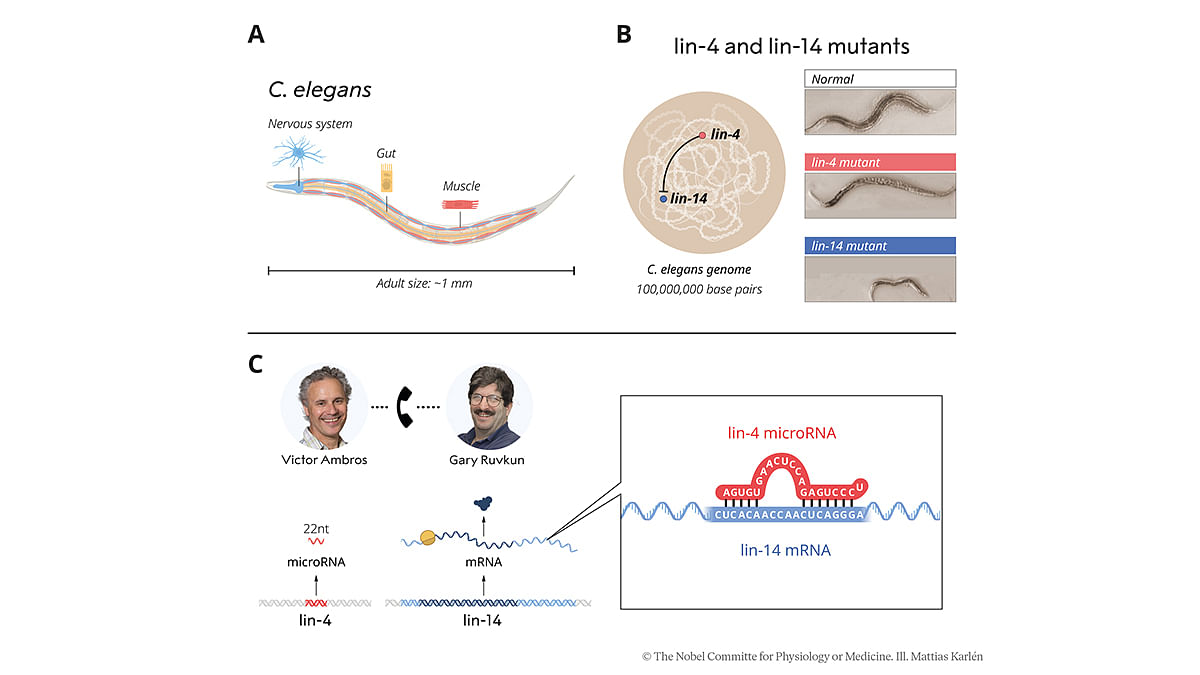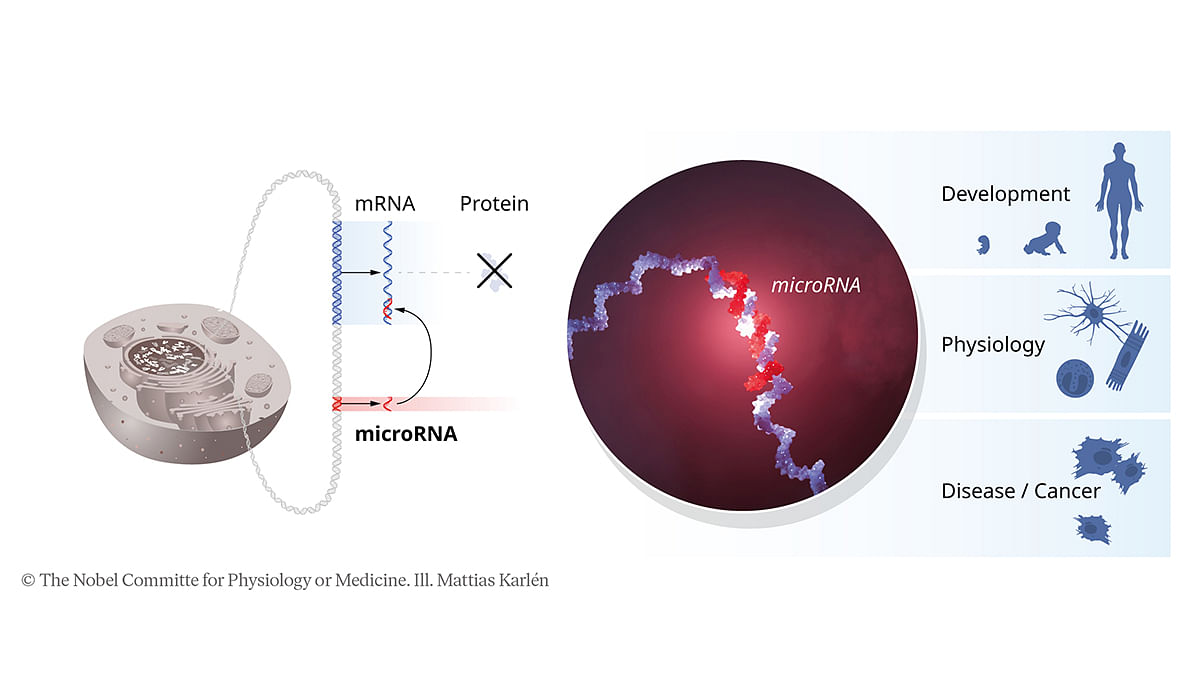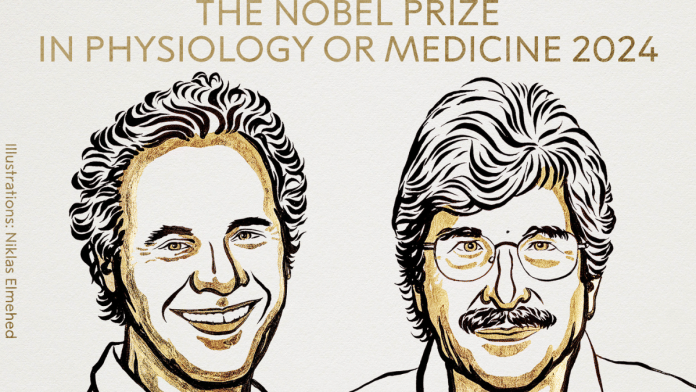New Delhi: American developmental biologist Victor R. Ambros and fellow molecular biologist Gary Bruce Ruvkun were awarded the 2024 Nobel Prize in Physiology or Medicine Monday.
They won the award for their discovery of microRNA—a class of tiny, non-coding RNAs that governs how gene activity and expression is regulated. Their research unveiled a novel principle of gene regulation that has been at work for hundreds of millions of years, and is crucial for the survival of multicellular organisms, including humans.
ThePrint explains what microRNAs are, their significance in gene regulation, how the Nobel laureates discovered them, and the physiological importance of microRNAs.
Living organisms have different types of cells with distinct characteristics, despite every cell containing exactly the same chromosomes. Chromosomes are made of genes, which are made up of sequences of genetic material called DNA, encode proteins by providing instructions, and carry hereditary information. The fact that all cells have the same chromosomes implies that every cell contains exactly the same set of genes and hence, the same set of instructions.
Going by this logic, the body should not have different cell types. But that is not the case because gene regulation allows each cell to choose only the relevant instructions, ensuring that only the correct set of genes are activated in each cell type. And this is where microRNAs come into the picture.
Also Read: Dolphins smile at each other during social play & Antarctica is ‘greening’ at dramatic rate
MicroRNAs: Tiny but indispensable
MicroRNAs do not code for proteins, but are imperative to regulating gene expression. There are over a thousand microRNAs in the human body, and are transcribed from DNA sequences. They regulate transcription or activate translation, which is the process by which information on a DNA strand is copied into a molecule of messenger RNA (mRNA).
Since microRNAs ensure that only the correct set of genes is active in each specific cell type, they are able to perform specialised functions.
Moreover, gene activity can be disrupted due to changing conditions in the body and external environment. This is also where microRNAs come to the rescue, fine-tuning gene activity to allow cellular functions to adapt to changes.
A small worm is the silent hero behind the milestone. In ‘Avengers: Endgame (2019)’, a mouse accidentally opened the portal to the Quantum Tunnel, which allowed Ant-Man to come out of the Quantum Realm after five years. He immediately went to the surviving Avengers, and gave them the idea of using time travel to bring everyone, who was turned to dust post Thanos’s snap, back to life.
Just as the mouse was an unsung hero in ‘Endgame‘, a small worm had a major role to play in the research that led Ambros and Ruvkun to discover microRNAs.
In the late 1980s, Ambros and Ruvkun were postdoctoral fellows in the laboratory of American biologist Robert Horvitz, whose research on the nematode worm Caenorhabditis elegans won him the 2002 Nobel Prize in Physiology or Medicine.
Both Ambros and Ruvkun studied this one-millimetre long roundworm. It has countless specialised cell types such as nerve and muscle cells, which are also found in larger, more complex animals. As a result, it was the perfect model to understand the development and maturation of tissues in multicellular organisms.
To understand the genetic machinery of C. elegans, Ambros and Ruvkun studied two mutant strains of the worm—lin-4 and lin-14.
The lin-4 and lin-14 genes were mutated due to defects in the timing of gene activation.
In a previous research, Ambros had found that the lin-4 gene served as a negative regulator of the lin-14 gene. But he did not know the mechanism behind this.
To unravel the mystery, Ambros cloned the lin-4 gene, and found that it produced an unusually short RNA molecule that didn’t have any code for protein production. The short RNA molecule was responsible for inhibiting the lin-14 gene.
But what exactly was this short RNA? To understand the mechanism in detail, Ruvkun studied the regulation of the lin-14 gene. He observed that contrary to how gene regulation was then known to function, it was not an mRNA molecule that inhibited the lin-14 gene. The inhibition occurred at a later stage in the mechanism of gene expression, and shut down protein production.
Ruvkun cloned the lin-14 gene, and observed that the lin-14 mRNA had a complementary sequence. After this, Ruvkun and Ambros compared their findings.
They observed that the short RNA molecule produced by the lin-4 gene, which was responsible for the inhibition of the lin-14 gene, matched the complementary sequence on the lin-14 mRNA. This short RNA molecule, or microRNA, was responsible for inhibiting lin-14.
The microRNA produced by the lin-4 gene, which inhibited lin-14, was named lin-4 microRNA.
The two scientists performed further experiments, and showed that the lin-4 microRNA binds to the complementary sequences on the lin-14 mRNA. This, in turn, blocks the production of lin-14 protein.

And this was how Ambros and Ruvkun discovered a novel principle of gene regulation, facilitated by a previously unknown type of RNA: microRNA. Their findings were published in 1993 in two papers in the journal Cell.
Initially, the scientific community thought the discovery, though interesting, was irrelevant to humans and other complex organisms. But a breakthrough by Ruvkun’s research group in 2000 created ripples in the scientific community.
The team had discovered another microRNA. It is encoded by the let-7 gene, which is highly conserved, and present throughout the animal kingdom. Following this discovery, hundreds of different microRNAs were identified and since then, there was no looking back.
Physiological significance of microRNAs

MicroRNAs are crucial to the physiological development and functioning of organisms, and disease prevention. This is because they play a major role in gene regulation by inhibiting protein synthesis, degrading mrNA or fine-tuning genes.
If gene regulation is amiss or microRNAs perform abnormal gene regulation, it can potentially lead to serious diseases such as autoimmune conditions, cancer and diabetes.
Scientists have found mutations in genes coding microRNAs in humans, and observed that these can lead to conditions such as eye and skeletal disorders, and congenital hearing loss, among others.
For instance, the DICER1 syndrome, a rare genetic disorder that increases the risk of developing cancerous and non-cancerous tumours, occurs due to mutations in one of the proteins necessary for microRNA production.
Researchers at the IIT Madras’ Department of Medical Sciences and Technology told ThePrint that the profound implications of the discovery are evident in the growing use of microRNAs for early disease detection and the development of novel therapies, especially in conditions like heart disease, cancer, and genetic disorders.
They said that the laureates’ contributions underscore the critical role of basic scientific research in shaping translational medicine and advancing personalised treatments.
The Nobel Prize not only honours the laureates’ transformative work but also highlights the vast potential of microRNA research in tackling some of the most challenging diseases, they asserted.
After the announcement of the Medicine Nobel, Professor Olle Kämpe, a member of the Nobel Committee for Physiology or Medicine, told a journalist that microRNAs “are a new layer in gene regulation”, creating a network that makes gene regulation more robust.
“It was discovered by Victor Ambros in 1993, but thought to be an oddity to a small worm—C. elegans—for more than seven years, until Gary Ruvkin detected a second microRNA (gene): let-7. And then, the field exploded. Now, more than tens of thousands of microRNAs have been identified in different organisms,” he said.
(Edited by Tony Rai)






